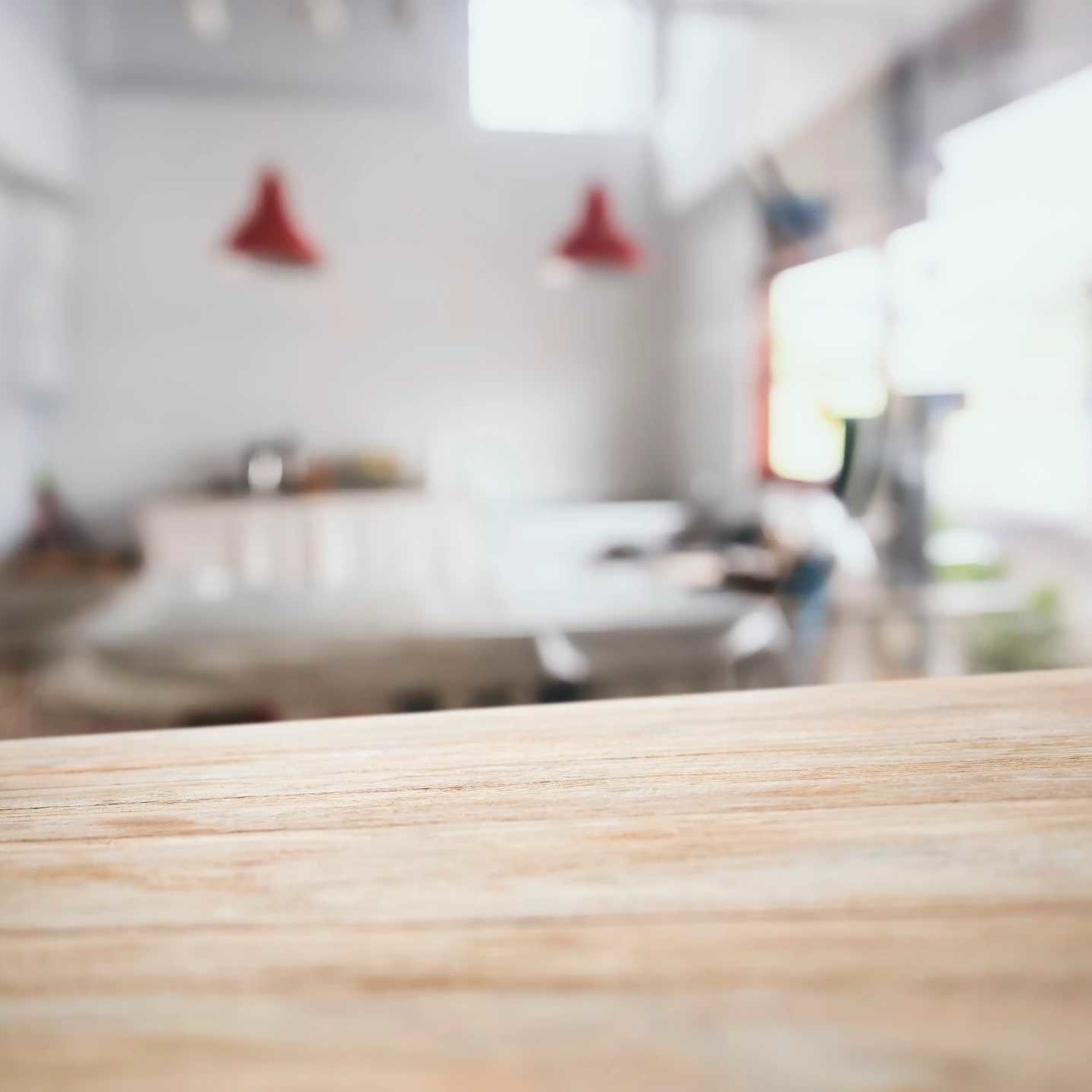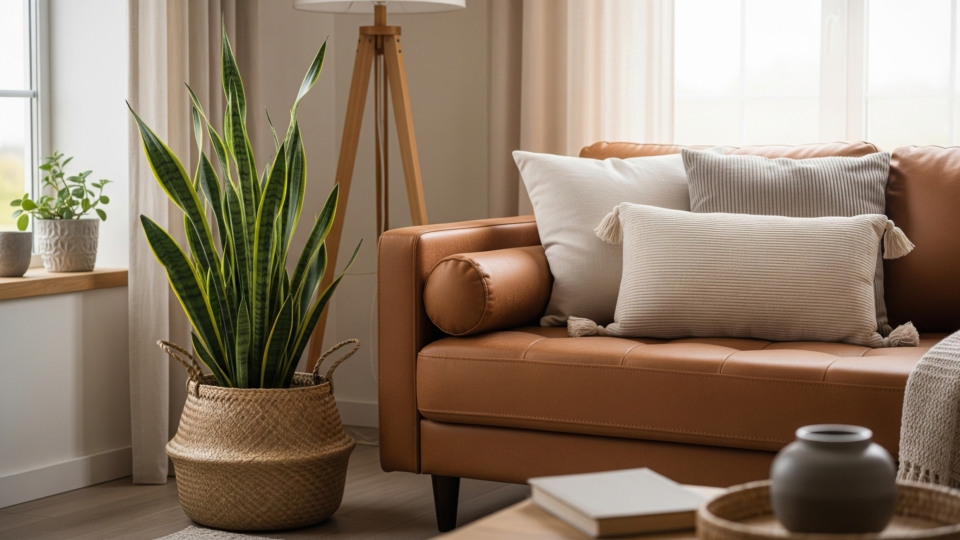
Interior Design Trends 2025: Why Sustainable Materials Are Trending This Year
As we move through 2025, one theme is impossible to ignore in home décor: sustainability. Interior design is experiencing a green revolution, with eco-friendly materials and design practices taking center stage. Homeowners and designers alike are seeking out ways to create beautiful spaces that are environmentally responsible, healthy for occupants, and rich with character. In this comprehensive guide, we’ll explore the top sustainable interior design trends of 2025 – and why they’re booming right now.
Homeowners in 2025 are more eco-conscious than ever. Sustainable materials are trending because people want to reduce their environmental impact and create healthier homes. Climate change awareness, eco-friendly innovations, and demand for quality, long-lasting decor drive this trend.
Examples include bamboo, cork, reclaimed wood, recycled metals and glass, organic cotton, hemp, and linen. Low-VOC or VOC-free paints also help improve indoor air quality.
Choose reclaimed or secondhand furniture, use low-VOC paints, add indoor plants, and install energy-efficient lighting. Adopt a minimalist mindset with durable, multi-purpose pieces.
The Rise of Sustainable Materials in Home Décor
Sustainable materials have transitioned from niche to new standard in interior design. According to design experts, “bold colors, multifunctional layouts, and sustainable materials are taking center stage in 2025 interiors”. In practice, this means designers are prioritizing renewable, recycled, and low-impact materials for everything from furniture to finishes. Driving this trend is a perfect storm of factors: heightened eco-consciousness, advances in material technology, and consumer demand for products that align with their values. Today’s homeowners want spaces that look stylish, but also do good for the planet.
Key sustainable materials trending in 2025 include:
- Reclaimed Wood and Metal: Furniture and flooring made from salvaged lumber or recycled metal has unique character and avoids new resource extraction. These pieces carry a history and reduce waste by giving old materials new life.
- Bamboo, Cork, and Fast-Growing Wood: Rapidly renewable and very durable, bamboo and cork are appearing in flooring, cabinetry, and even decor accents. They lend warmth and texture while being environmentally friendly to harvest.
- Recycled Plastics and Glass: From rugs made of recycled PET bottles to countertops composed of crushed glass, upcycled synthetics are in. These innovative materials keep waste out of landfills and often look indistinguishable from new.
- Organic Fibers and Fabrics: Natural textiles like organic cotton, hemp, linen, and recycled fiber blends are replacing synthetics in upholstery, drapery, and rugs. They’re biodegradable and produced with fewer chemicals.
- Low-VOC Finishes and Paints: In paints, stains, and sealants, 2025’s focus is on non-toxic, VOC-free options that don’t off-gas harmful chemicals. Homeowners are opting for water-based finishes, plant-based oils, and mineral paints to improve indoor air quality.
Home product manufacturers have responded to the demand by rolling out exciting eco-material innovations. For example, furniture makers are debuting lines using FSC-certified wood, bio-based plastics, and even mushroom mycelium composites. The ethos is clear: sustainable design is not a sacrifice but an upgrade. By embracing materials that are responsibly sourced and long-lasting, you create spaces that are stylish, durable, and better for the planet. Little wonder that sustainable design continues to dominate interiors in 2025.A trend that shows no signs of fading.
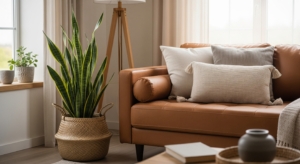
Moreover, sustainability has become a new marker of quality. Rather than flimsy “fast furniture,” people are gravitating to heirloom-quality pieces made with care. It’s an investment mindset: a solid oak dining table or wrought-metal light fixture might cost more up front, but will last decades (and save resources in the long run). This shift aligns with a broader cultural move away from disposable décor. Consumers are choosing high-quality, long-lasting materials over mass-produced décor that fills landfills, finding beauty in pieces that tell a story. In short, sustainability has style now. And that’s why it’s everywhere.
Biophilic Design: Bringing Nature Indoors
One of the most popular movements fueling the sustainable decor trend is biophilic design – a design approach that connects interiors with nature. Biophilic elements have become must-haves in 2025 homes, as people recognize the wellness and aesthetic benefits of bringing the outdoors in. Hallmarks of this trend include abundant indoor plants, natural light, water features, and nature-inspired textures. In fact, biophilic design is one of the most popular sustainable home decor ideas for 2025, seamlessly integrating greenery and natural elements into indoor spaces.
Designers are getting creative in how they incorporate nature: think living green walls of trailing vines, herb gardens in the kitchen, and sunlit atriums that make you feel outdoors. Large floor-to-ceiling windows and skylights are also in high demand, reducing the need for daytime lighting and offering views of surrounding landscapes. Even in urban apartments, people are dedicating corners to lush clusters of houseplants to create a mini oasis.
The benefits go beyond visuals. Houseplants actively improve indoor air quality by filtering toxins and producing oxygen. Natural light and views of greenery have been shown to boost mood and productivity. Homeowners find that biophilic touches make a space feel calm, lively, and healthy – all at once. As designer Sean Mullin notes, plants offer both aesthetic appeal and stress reduction, which is why layering greenery throughout your home will continue to flourish as a trend.
To get the biophilic look, consider these ideas:
- Green Corners: Dedicate a well-lit corner to a collection of potted plants in varying heights. Mix floor plants (like a fiddle-leaf fig or snake plant) with tabletop succulents for interest.
- Natural Views: If you have a window with a view of trees or a garden, orient key furniture (sofas, desks) to face it. No view? Use nature-inspired artwork or photography as a beautiful substitute.
- Earthy Materials: Incorporate finishes that echo nature – stone accent walls, wood ceilings or beams, rattan and jute furniture, and organic patterns (leaf motifs, floral prints) in textiles. These bring tactile connections to the outdoors inside.
- Water & Light: The gentle trickle of an indoor fountain or the glow of plenty of daylight can create a serene, nature-like atmosphere. Reflective surfaces and mirrors can amplify natural light, brightening the space sustainably.
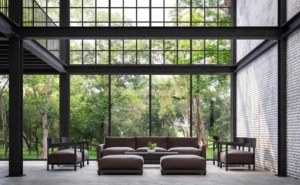
Biophilic design isn’t just a style – it’s also linked closely with sustainability. By prioritizing natural light, you reduce electricity use. By caring for plants, you become attuned to natural rhythms and maybe even start incorporating more eco-friendly habits. It’s a holistic approach to design that nurtures both people and the planet. No wonder biophilic elements are virtually standard in trendy interiors now – they make our homes feel alive.
Circular Design & Upcycled Décor: The Zero-Waste Mindset
Another powerful trend in 2025 interiors is the embrace of circular design principles – essentially, designing out waste and keeping materials in use as long as possible. This manifests in the growing popularity of reclaimed, upcycled, and vintage décor. Rather than buying all new mass-produced items, many homeowners are hunting for unique secondhand finds or repurposing what they already own. In fact, zero-waste decor is growing in popularity, with more people choosing to repurpose old furniture and materials instead of buying new. This creative, budget-friendly approach also happens to significantly reduce environmental impact.
Upcycled décor can take many forms. We see coffee tables made from old factory pallets, antique doors turned into headboards, and mason jars becoming pendant lights. Thrift stores, flea markets, and online marketplaces (like Facebook Marketplace and Chairish) are treasure troves for finding pieces with characters that just need a little love. Designers are encouraging clients to hold onto quality furniture and refinish or repaint it to give it a fresh look rather than discarding it. The mantra is “old is new again” – and in a sustainably designed home, a vintage rug or mid-century chair can actually become the stylish focal point of the room.
Key benefits of the circular decor trend include:
- Less Waste: Obviously, using what exists means fewer items heading to landfill. It also cuts down demand for manufacturing new goods (saving energy and raw materials).
- Unique Character: Upcycled and vintage pieces bring a sense of history and uniqueness that brand-new items often lack. As one designer put it, these pieces “tell stories… making each piece truly one-of-a-kind” in your home.
- Cost Savings: Often, secondhand finds are more affordable – or even free if you’re repurposing items you have. Sustainability can thus be friendly to your wallet as well.
- Personal Creativity: DIY-ing an upcycle project infuses your personality into the space. From repainting an old dresser in a bold eco-friendly paint to reupholstering dining chairs in organic fabric, you get functional art that you made yourself.
For those unsure where to start, begin with small DIY upcycles. Maybe turn an old ladder into a bookshelf, or use reclaimed wood planks to build floating shelves. Even incorporating a few vintage accessories – like antique mirrors, thrifted ceramics, or retro light fixtures – can lend that sustainable, eclectic charm. Every item saved from the dump counts!
Importantly, big furniture retailers are also embracing circularity. Some offer buy-back or refurbishing programs for their products, and we’re seeing new lines crafted from recycled or composite materials. The influence of the circular economy mindset is permeating design: manufacturers are exploring cradle-to-cradle production, and designers are choosing products with recycled content or that can be easily disassembled and recycled in the future. All these efforts align with a larger vision – an interior design industry that thrives on reuse and regeneration rather than constant consumption.
Health-Conscious Interiors: Non-Toxic Materials & Wellness-Focused Design
In 2025, homeowners are not only thinking about the planet’s health – they’re focused on personal health in their living spaces too. This has given rise to health-conscious interiors that prioritize non-toxic materials, good indoor air quality, and overall wellness through design. As knowledge grows about indoor pollutants (like VOCs, formaldehyde, and even microplastics), there is an increased demand for non-toxic materials and sustainable sourcing in home furnishings. People want to know that the paint on their walls or the finish on their floors isn’t emitting harmful chemicals, and that the fabrics they lounge on aren’t treated with irritants.
Key elements of the wellness design trend include:
- Low- and No-VOC Products: Conventional paints, adhesives, and finishes can release volatile organic compounds (VOCs) that degrade air quality and harm health. In response, many are opting for VOC-free paints, natural wood finishes, and formaldehyde-free adhesives. For instance, clay- or lime-based paints and water-based polyurethanes provide beautiful results without the fumes.
- Natural Fiber Textiles: Upholstery and bedding are moving toward organic and untreated fibers. Cotton, linen, wool, hemp, and TENCEL (from eucalyptus) are favored over synthetics that may be off-gas or have chemical treatments. These materials are breathable and hypoallergenic, contributing to a healthier home.
- Chemical-Free Furniture: Pressed wood furniture and cabinetry often contain formaldehyde in glues; now consumers are seeking out brands that use formaldehyde-free plywood or solid wood. Likewise, foam cushions can contain flame retardants, so many sofas and mattresses now boast certifications (like Greenguard Gold or CertiPUR-US) verifying low chemical emissions.
- Improved Air & Water: Beyond materials, wellness design encompasses features like advanced air filtration systems, indoor air purifiers, and water filtration for drinking water. Even simpler, adding plenty of plants acts as a natural air filter – plants like peace lilies, snake plants, and pothos are known to help remove toxins in the air.
This focus on health is backed by experts. A recent industry report noted that “concerns over VOCs and formaldehyde have increased dramatically. Clients are requesting non-toxic paints, natural fiber textiles, and other health-focused design elements.” Designers are responding by vetting materials used in projects and often choosing the “cleanest” options available – from cabinetry finishes to carpet pads – to ensure a space that not only looks good but nourishes the people inside it.
Wellness-focused design also overlaps with comfort and well-being trends: think calming color palettes, ergonomic furniture, and spaces that encourage relaxation or mindfulness. For example, homeowners might dedicate a small area as a yoga/meditation nook or ensure the bedroom design promotes good sleep (with blackout curtains, air-purifying plants, etc.). The overarching idea is that your home environment has a direct impact on your health – both mental and physical. By using non-toxic, organic materials and thoughtful design, you reduce stress on your body (literally breathing easier) and create a sanctuary that supports a healthy lifestyle.
In summary, health-conscious interior design in 2025 is all about merging eco-friendly choices with personal well-being. It recognizes that sustainability isn’t just about the planet; it’s also about crafting homes that enable us to thrive.
Local & Artisanal Craftsmanship Make a Comeback
Sustainability in interior design isn’t only about what materials you use, but also how and from where things are made. This year we’re seeing a renaissance of artisanal and locally made decor.
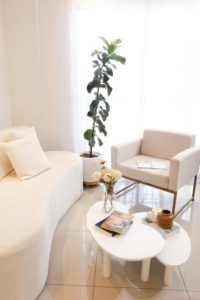
Homeowners are seeking out furniture and accessories from local craftspeople or ethical brands, rat
her than mass-produced imports. This ties into sustainability in multiple ways: supporting local businesses reduces shipping emissions and often means items are made in smaller batches with more care. Additionally, artisans tend to use quality natural materials and time-honored techniques, resulting in
pieces built to last for generations.
There’s a growing appreciation for the story and craftsmanship behind items in our homes. A hand-thrown ceramic vase from a local potter or a dining table crafted by a regional woodworker imbues a space with authenticity. These items often use sustainable practices – for example, a local woodworker might source hardwood from storm-felled trees or reclaimed barn wood, and use natural oil finishes. Textile artisans might use organic dyes and fabrics. The result is decor that is one-of-a-kind, environmentally mindful, and supports your community.
Consumers are increasingly aware that fast, cheap décor comes at an unseen cost, whether it’s pollution from factories or questionable labor practices. In contrast, choosing durable, meaningful pieces made by skilled artisans aligns with a sustainable and ethical lifestyle. This is part of a broader shift towards what the American Society of Interior Designers calls “meaningful spaces” – where narrative and personal connection matter. People take pride in saying, “This rug was woven by a collective that supports indigenous weavers,” or “This lamp was made by a blacksmith using recycled metal right here in my state.” Such connections turn a house into a richer story about values and heritage.
Some ways to ride this artisanal trend:
- Shop Local Galleries & Markets: Instead of defaulting to big-box stores, browse local artisan markets, craft fairs, and boutique galleries. You may discover unique furniture, art, and decor with a regional flavor.
- Commission Custom Pieces: Many craftspeople take custom orders. Commissioning a piece (like a live-edge dining table or a stained-glass window) ensures you get exactly what you want, often using local materials, and you form a relationship with the maker.
- Handmade Textiles: Look for handwoven baskets, rugs, and throws. Not only are these often made from natural fibers, but buying them often supports traditional crafts (and they add lots of texture!).
- Vintage & Heirloom Revival: Embrace “something old, something new.” Mix newly crafted artisan pieces with family heirlooms or vintage finds. As noted earlier, refinishing heirlooms is both sentimental and sustainable – and artisans can help with the refurbishment process too.
Ultimately, incorporating artisanal elements contributes to a more sustainable, human-centered home. You end up with higher-quality items that have longevity (reducing the need to replace things) and interiors that feel soulful and curated rather than cookie-cutter. It’s interior design with a conscience – and that’s a trend we can all feel good about.
Minimalism and Timeless Design Over “Fast Fashion” Décor
A notable side effect of the sustainable materials movement is a resurgence of minimalist, timeless design principles. To put it simply, “less is more” has taken on new relevance in an age of climate awareness. Rather than stuffing homes with short-lived trendy items, many people are adopting a more restrained, curated approach – choosing fewer pieces that make a big impact and can endure style changes. This approach inherently reduces waste and resource use. In 2025, the leading eco-friendly decor trends include minimalist aesthetics that favor quality over quantity.
Minimalism in this context doesn’t mean a stark, cold home. Today’s sustainable minimalism is warm and “cozy” – sometimes dubbed warm minimalism or the Japandi style (which blends Japanese and Scandinavian sensibilities). It means a neutral, calming color palette, clean lines, and clutter-free spaces, accented by a few organic textures like wood, stone, or plants to add character. Every item is intentional. By decluttering and paring back, you not only create a more tranquil environment, but you also avoid the cycle of constantly buying and replacing decor.
Here are some key principles of sustainable minimalism and timeless design:
- Invest in Classics: Opt for furniture with classic silhouettes or mid-century modern lines that never really go out of style. These pieces can form the backbone of your decor for decades. For example, a well-made neutral sofa or a solid wood credenza can adapt to many aesthetics as you update smaller accents around them.
- Neutral Base, Flexible Accents: Use a neutral base (walls, larger furniture) in whites, beiges, greys, or earth tones. This provides longevity. Then add pops of color or trendier patterns through easily changeable items like throw pillows, artwork, or rugs. It’s much less wasteful to swap out a cushion cover than an entire couch if tastes change.
- Multi-Functional Spaces: A sustainable home often does more with less space. Embrace designs that allow rooms and furniture to serve multiple purposes (e.g., an ottoman with storage inside, a dining table that doubles as a work-from-home desk). Fewer items can meet all your needs.
- Quality Materials & Craftsmanship: Just as with the artisanal trend, prioritize solid construction and durable materials. A hand-knotted rug, though pricier, might last generations, whereas a cheap synthetic one might wear out in a few years. The long view saves resources and money over time.
By following these approaches, homeowners not only reduce clutter and waste but also find that their interiors remain effortlessly chic. A minimalist, nature-inspired living room with a few well-chosen sustainable pieces will look as good in 2030 as it does now – which is exactly the point. Sustainability is the opposite of disposable design. It encourages us to slow down, choose deliberately, and find satisfaction in having less but enjoying it more.
Minimalist, timeless design dovetails with sustainability because it resists the urge to constantly consume. It’s an antidote to “fast fashion” in décor, where items are trendy one season and trash the next. Instead, it’s about creating a canvas you love and adding layers only when truly needed or deeply desired. The result is a home that feels calm, authentic, and enduring – a true refuge.
Conclusion: Style Meets Sustainability in 2025
Interior design trends in 2025 prove that sustainability and style can beautifully coexist. In fact, sustainable materials and design practices are not just a trend – they represent an evolution in how we think about our homes. From incorporating natural materials and biophilic touches, to upcycling treasures and choosing toxin-free finishes, each eco-conscious choice adds up to spaces that reflect our values and care for our well-being.
What’s exciting is that going green with your interiors no longer means compromising on aesthetics. The wide array of sustainable products and creative design solutions available today make it easier than ever to have a home that is both chic and environmentally friendly. Whether you start by swapping in organic linens, repainting with VOC-free paint, or saving that old chair from the curb and giving it a makeover, every step toward sustainability counts. These trends aren’t about a one-season look – they’re setting the foundation for the future of interior design.
As you refresh your living spaces, remember that sustainability is a journey, not a destination. Even small changes can have a positive impact. Embrace the natural patina of aging materials, the comfort of a plant-filled nook, or the story behind a handcrafted object. Your home will not only be on-trend for 2025, but it will also be part of a greater movement toward living more harmoniously with our planet and our own health. And that is a design direction that will never go out of style.
By adopting the sustainable interior design trends of 2025, you’re not just following fashion – you’re creating a home that truly cares.
If you’re looking for a design approach that perfectly complements sustainable choices, explore our guide, Interior Design Trends 2025: Incorporating Minimalist Style into Your Home. Minimalism’s focus on simplicity, intentionality, and open space pairs beautifully with eco-friendly materials, allowing each element to shine. Together, they create interiors that are both visually serene and deeply mindful of the planet.
